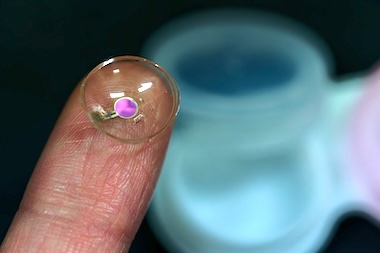
A project at South Korea's KAIST research center has incorporated OLED light sources into a thin flexible contact lens, to create a next-generation ophthalmic diagnostic technology.
The breakthrough is expected to have applications in diverse fields such as myopia treatment, ocular biosignal analysis, augmented-reality (AR) visual information delivery and light-based neurostimulation, according to KAIST.
"On-eye optoelectronic systems can address unmet needs across various healthcare applications, including monitoring of physiological signals related to vision or other diseases," noted the project in its ACS Nano paper.
"This work introduces wearable light sources that combine ultrathin organic light-emitting diodes (OLEDs) with contact lenses."
The new lens could in particular help clinicians to carry out electroretinography (ERG), in which the electrical responses of various cell types in the retina are measured. This typically requires a complex diagnostic arrangement, in which patients must keep their eyes open and remain still in a dark room while an external light source and imaging unit is held up to the eye.
To overcome these limitations, the KAIST team integrated an ultrathin flexible OLED approximately 12.5 microns thick into a contact lens electrode. It also equipped the lens with a wireless power receiving antenna and a control chip, completing a system capable of independent operation.
"Unlike conventional ERG, which requires a darkened space, our work allows patients to rest comfortably, even with their eyes closed during measurements, illustrating its potential to significantly benefit both patients and ophthalmologists," said the project.
Cool work: low heat levels on the eye
Most smart contact lens-type light sources developed for ocular illumination have used inorganic LEDs, commented KAIST, an approach leading to rigid devices and excessive heat accumulation, which limits usable light intensity. In contrast, OLEDs are areal light sources shown to induce retinal responses even under low luminance conditions.
In trials the KAIST device delivered a relatively low luminance of 126 nits but still successfully induced stable ERG signals, producing diagnostic results equivalent to those obtained with existing commercial light sources. Animal tests confirmed that the surface temperature of a rabbit’s eye wearing the OLED contact lens remained below 27 degrees C, avoiding corneal heat damage.
Power was provided by wireless transfer using a 433 MHz resonant frequency controller, and the project embedded the wireless controller in a sleep mask linked to a smartphone, further enhancing practical usability of the device for patients.
"Integrating the flexibility and diffusive light characteristics of ultrathin OLEDs into a contact lens is a world-first attempt," commented KAIST's Seunghyup Yoo.
"This research can help expand smart contact lens technology into on-eye optical diagnostic and phototherapeutic platforms, contributing to the advancement of digital healthcare technology."












